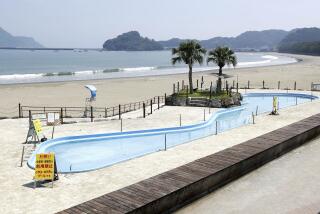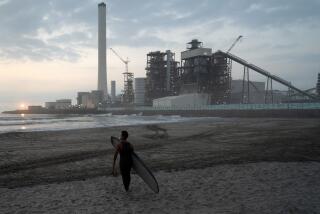New Gas Attack in Japan Sends 372 to Hospital
- Share via
TOKYO — Another poisonous gas attack created pandemonium in the capital region Wednesday, but 372 Japanese treated at 33 hospitals for coughing, sore eyes and dizziness were reported in no danger of death.
There were reports that victims showed symptoms of exposure to phosgene, a poison gas used in World War I. But two other poison gases were also named as the possible weapon afflicting passengers riding in a train and pedestrians walking through an underground passageway in Yokohama Station. The station is used by about 1.5 million people each day.
Home Affairs Minister Hiromu Nonaka assured Parliament that no sarin nerve gas was released. “None of those hospitalized for treatment faces a life-threatening situation,” he said.
Nonaka offered the special report as both houses of Parliament on Wednesday were unanimously passing a law banning the production and use of sarin and other dangerous chemicals. Penalties range up to life imprisonment.
Police were treating the Yokohama case as another indiscriminate terrorist attack similar to the still-unsolved March 20 sarin attack on Tokyo’s subways that killed 12 and afflicted more than 5,500.
Shortly after midnight today, police arrested Kiyohide Hayakawa, 45, who was described as deputy leader of the Aum Supreme Truth sect that claims 17,000 Japanese followers and is suspected of staging the sarin attack. He was taken into custody at the sect’s compound near Mt. Fuji after appearing on a late-night television news show.
The charge against him--breaking into a garage where a car was found containing materials used for making guns--did not link Hayakawa to either of the gas attacks.
In the television interview, Hayakawa admitted that he had visited Russia, where the sect has 30,000 followers, more than 20 times and had been in charge of purchasing a Russian military helicopter through Austria for nearly $1 million.
But he said neither he nor any cult member was involved in the gas attacks.
Early today, 21 people remained hospitalized for observation after the incident in Yokohama, located about half an hour from Tokyo by train. But all others had been released. Doctors, noting their inability to specify what substance had caused the afflictions, warned patients to report any new symptoms immediately.
The initial alarm from the latest incident stirred a crisis-like reaction.
Prime Minister Tomiichi Murayama, roundly criticized for his tardy response in calling out rescue forces after a 6.9-magnitude earthquake struck the port city of Kobe on Jan. 17, dispatched to Yokohama more than 50 emergency vehicles and thousands of police, firefighters and chemical weapons experts from the Self-Defense Forces.
Police throughout Tokyo also were put on alert. Vehicles traveling between Yokohama and Tokyo were inspected. Armed guards started patrolling Bullet Line trains operating in the countryside.
More than 300,000 students at Yokohama’s 507 schools were held until they were advised it was safe to go home.
Police were reported re-examining a similar case involving fumes that struck a train in Yokohama on March 5. Although 11 people suffered minor afflictions, that incident--which occurred 15 days before the sarin subway attack--attracted little attention at the time.
Experts still have not been able to identify the substance that caused the fumes in the March 5 incident.
In Wednesday’s incident, passengers on a train traveling from Tokyo reported detecting a foul odor as they approached Yokohama Station and disembarked there shortly before 1 p.m.
Still others, who said their throats became sore after leaving Yokohama, fled the train five minutes later at Kannai Station. More complaints emerged as the train pulled into Ishikawa-cho Station two minutes after that.
Railway officials inspected the train at Ishikawa-cho Station for eight minutes but found nothing strange. The train continued for 23 minutes before officials cut short its run and asked 500 remaining passengers to get off and take another train.
Also about 1 p.m., pedestrians in an underground passageway beneath Yokohama Station started feeling dizzy and sick and sought help from station employees.
Police have arrested more than 100 Supreme Truth members and reported finding tons of chemicals, some of which they claimed could be used to produce but sarin. But no one has yet been charged with carrying out the March 20 attack.
The group’s partially blind, bearded spiritual leader, Shoko Asahara, 40, who has urged his followers to prepare to defend themselves in the Armageddon he says will break out between Christians and Buddhists in 1997, has been in hiding since the attack.
More to Read
Sign up for Essential California
The most important California stories and recommendations in your inbox every morning.
You may occasionally receive promotional content from the Los Angeles Times.













